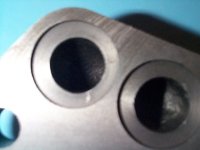JerryG
Super Member
Re: Rear hydraulic on Kubotas the less expansive way
<font color="blue"> The 2 parallel surfaces of the mounting block must be symmetrical with each other so that the clamping pressure of the bolts exerts equal pressure over the whole surface of the "O" rings. Any surface irregularities in the mating surfaces would negate this uniform pressure. I am familiar with the mounting block itself and the mating surface is machined to a high degree of flatness. </font>
In your first post you also stressed that a surface grinder was required. Look at this picture. Those are mill marks. You don't get them from a surface grinder. This is a similar housing cap.
<font color="blue"> The 2 parallel surfaces of the mounting block must be symmetrical with each other so that the clamping pressure of the bolts exerts equal pressure over the whole surface of the "O" rings. Any surface irregularities in the mating surfaces would negate this uniform pressure. I am familiar with the mounting block itself and the mating surface is machined to a high degree of flatness. </font>
In your first post you also stressed that a surface grinder was required. Look at this picture. Those are mill marks. You don't get them from a surface grinder. This is a similar housing cap.

